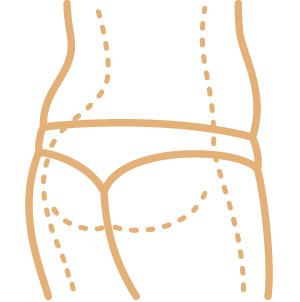
BodyLuxe Team
September 13, 2022

After you’ve had a surgery of any kind, it is imperative that you follow the post-op instructions you were given. Fat Transfer surgery is no different! As a matter of fact, in order to achieve and maintain the results you paid for, the post-op and recovery process is critical.
The first thing you should do is make sure you have all of the recommended supplies and products on hand BEFORE you have the surgery. For a fat transfer, this can include garments, specialized pillows and even apparatuses to assist you in using the restroom after having this procedure. Your doctor and nursing staff will assist you in understanding how to use these as well as how and where to get them.
Keep in mind that it is normal and expected to lose approximately 25-30% of the fat that is transferred. Some of the fat will just not survive the process and that is to be expected. However, there are things you can and should do to ensure that most of the fat survives and thrives in its new environment.
Here is an overview of some helpful tips and instructions that you should be prepared to follow for the best results:
Garments: These specially designed garments are meant to fit tightly in the area where fat has been removed. They help with compression of the area which will help reduce swelling, inflammation and even some bruising. They will also assist with skin contraction and smoothing the surface of the area treated. You will need to wear these garments 23 out of 24 hours a day (only taking it off to shower or to wash the garment) for the first 2 weeks at a minimum. After that, you can wear them as much or as little as you desire.
Pillow(s): There are specially designed pillows for you to use to prevent placing any pressure in the area you transferred the fat to. For example, after a BBL, you will need a pillow to allow you to sit without compressing the parts of your buttocks that you would typically sit on. This pillow should be used while you drive, while sitting at a desk for your job and even at home while sitting down to eat or watch television. When possible, it is recommended that you lie on your stomach to avoid pressure on this area altogether.
Sleeping: As mentioned above, you will not want to sleep and apply pressure to any area where fat has been transferred. For the breasts, we ask that you sleep on your back while wearing a supportive bra and for the buttocks you should sleep on your stomach. Body pillows can be placed around you strategically to help prevent you from rolling over during your sleep if these are not positions you typically sleep in.
Exercise: Rest is going to be essential during recovery – your body needs time to heal and adjust to its new form.This is especially true during the first few weeks. Light activity is recommended almost immediately but you should avoid vigorous exercise or strenuous exertion such as lifting or straining for a minimum of 3 weeks following surgery.
Diet: The fat that has been transferred is trying to find its new “home”. It takes time for it to settle into place and function like the rest of the fat cells within your body. This means you must take extra care of them and make sure you are “feeding” them properly. This is not to say that you should try to gain weight or eat excessively but you certainly should not restrict calories or try to lose weight while the fat is adapting to its new environment. Losing weight may mean losing that fat you transferred, making the procedure less effective.
Clothing: Wear loose, comfortable clothing that does not restrict the area (with the exception of the garments your medical team recommended). For example, tight jeans are not recommended for the first 2 months. Also keep in mind that initial swelling as well as your new body shape will affect how your clothes fit – so clothing that fit you well before might not with your new dimensions.
These are just some of the things to keep in mind. Your doctor may have more specific instructions for you, based on your unique circumstances and the specific procedure(s) you had done. As always, you should listen to the advice of your medical team above all else. If you follow their instructions and take care of yourself during the entire process, you will be able to achieve the best results possible!
Do you have more questions? Give us a call!
Sleigh the Season Sculpting Special 🎄
Shape your most confident silhouette this holiday season with BodyLuxe’s exclusive Sleigh the Season Sculpting Special. For a limited time, sculpt any 2 body areas and get a 3rd area free when you choose our signature FormSculpt® Lipo, Brazilian Butt Lift, Fat Transfer to the Breasts or Hands.
This limited-time offer ends January 31, and appointments are filling quickly.
Tap below to reserve your consultation and let BodyLuxe sculpt the look you’ll love showing off all season long.